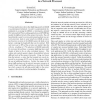Free Online Productivity Tools
i2Speak
i2Symbol
i2OCR
iTex2Img
iWeb2Print
iWeb2Shot
i2Type
iPdf2Split
iPdf2Merge
i2Bopomofo
i2Arabic
i2Style
i2Image
i2PDF
iLatex2Rtf
Sci2ools
QEST
2007
IEEE
2007
IEEE
A Petri Net Model for Evaluating Packet Buffering Strategies in a Network Processor
Previous studies have shown that buffering packets in DRAM is a performance bottleneck. In order to understand the impediments in accessing the DRAM, we developed a detailed Petri net model of IP forwarding application on IXP2400 that models the different levels of the memory hierarchy. The cell based interface used to receive and transmit packets in a network processor, leads to some small size DRAM accesses. Such narrow accesses to the DRAM expose the bank access latency, reducing the bandwidth that can be realized. With real traces up to 30% of the accesses are smaller than the cell size, resulting in 7.7% reduction in DRAM bandwidth. To overcome this problem, we propose buffering these small chunks of data in the on chip scratchpad memory. This scheme also exploits greater degree of parallelism between different levels of the memory hierarchy. Using real traces from the internet, we show that the transmit rate can be improved by an average of 21% over the base scheme without the u...
| Added | 04 Jun 2010 |
| Updated | 04 Jun 2010 |
| Type | Conference |
| Year | 2007 |
| Where | QEST |
| Authors | Girish B. C., R. Govindarajan |
Comments (0)

